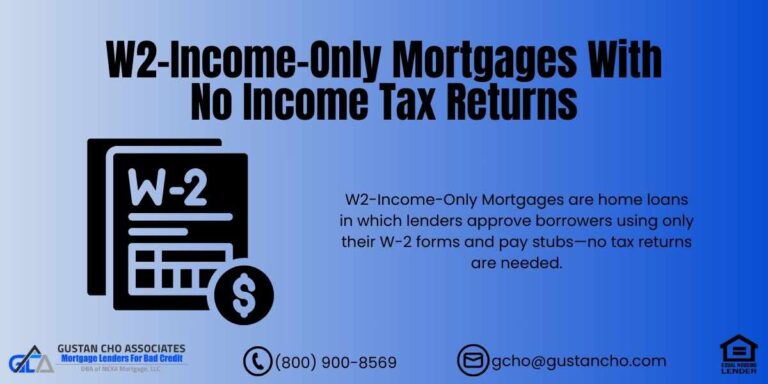What Are the the Gaps in Employment Guidelines for a Mortgage
This guide covers getting qualified and approved for a mortgage with a gap or multiple gaps in employment in the past two years. If someone wants to apply for a mortgage, there are certain requirements. Credit and income play are two of the many factors mortgage underwriters will scrutinize when underwriting a mortgage loan applicant. Lenders require a tri-merger credit report on all new mortgage loan applicants. A tri-merger credit report is a credit pull from each of the three major credit bureaus. Most creditors, such as auto finance companies, credit card companies, and banks, will just pull one credit report from one of the three credit bureaus when determining the loan applicant’s credit profile. John Strange, a senior mortgage loan officer at Mortgage Lenders for Bad Credit, says the following about how home loans are underwritten by mortgage underwriters:
Since there is a lot of risk with mortgages, lenders do not want to take a chance and make sure they analyze and review each of the three credit bureaus. The median size of a mortgage on an average 3-bedroom, 2-bathroom, 1,700 square foot single-family home is $542,250. Mortgages are big-ticket items with small profit margins if the borrower defaults and/or forecloses on a home loan.
Therefore, lenders need to be careful when they are processing and underwriting borrowers. The ability to repay is determined by income and the borrower’s credit payment history. The borrower’s payment history from the credit report will determine the borrower’s history on how he or she pays their monthly debt obligations over the years. The borrower’s income determines the means of the borrower in paying their new mortgage payments. Mortgage underwriters want to make sure the borrower’s current job is stable, strong, and likely to continue for the next three years. This is the main objective and focus when mortgage underwriters process borrowers with gaps in employment in the past two years. Gaps in employment have allowed in the past two years. However, there are rules and regulations on gaps in employment when borrowers are qualifying for a mortgage.
General Guidelines on Gaps in Employment for a Mortgage
Here’s a detailed breakdown of how gaps in employment are handled under mortgage guidelines, addressing your questions about qualifying with employment gaps in the past two years, transitions between 1099 and W-2 jobs, gaps across different fields, and probationary jobs like police officers or firefighters. This is based on general mortgage lending practices (FHA, VA, USDA, and Conventional loans) as of March 22, 2025.
Worried About Gaps in Employment for Your Mortgage? We Can Help
Apply Now And Get recommendations From Loan Experts
Mortgage lenders typically evaluate a borrower’s employment history over the past two years to assess income stability and the likelihood of continued employment. Gaps in employment don’t automatically disqualify you. Still, they require explanation and may affect approval depending on the loan type, duration of the gap, and your current employment status. Here’s how it works:
Short Gaps in Employmetn (Less Than 6 Months)
Most loan programs (FHA, VA, USDA, Conventional) allow gaps of up to 6 months within the past two years without significant issues, provided you’re currently employed and can show income stability. A **letter of explanation** is often required to clarify the gap (e.g., maternity leave, medical reasons, education, job transition).
Long Employment Gaps (6 Months or More)
Gaps exceeding 6 months typically trigger stricter scrutiny. You may need to be employed at your current job for at least 6 months before qualifying, and underwriters will assess your prior work history for consistency.
Documentation
Lenders usually request pay stubs, W-2s, 1099s, tax returns, and a Verification of Employment (VOE) to piece together your two-year history. For gaps, additional proof (e.g., school transcripts and medical records) might be needed.
Can a Borrower Qualify with Gaps in Employment in the Past Two Years?
Yes, borrowers can qualify with gaps in employment, but it depends on the loan type and circumstances:
FHA Loans Employment Gap Guidelines
- Gaps under 6 months are generally fine with a letter of explanation.
- Gaps over 6 months require you to be at your current job for at least 6 months with a two-year work history before the gap (doesn’t need to be continuous).
- For example, if you were unemployed for 8 months a year ago, you’d need 6 months at your current job and evidence of prior work.
VA Loans Employment Gap Guidelines
- Gaps over 60 days in the past two years require a 12-month history at your current job.
- Shorter gaps (under 30 days) are typically overlooked.
- Veterans can use military service as part of their work history.
USDA Loans Employment Gap Guidelines
- Similar to FHA—gaps under 6 months are manageable with explanation; longer gaps require 6 months at the current job.
Conventional Loans (Fannie Mae/Freddie Mac) Employment Gap Guidelines
- Fannie Mae has no strict maximum gap limit but prefers two years of stable income.
- Gaps under 6 months are usually acceptable with a new job’s pay stub and offer letter.
- Freddie Mac requires a 12-month work history in the last 24 months if gaps exceed 6 months, along with a letter of explanation.
Key Takeaway
- Yes, approval is possible with gaps, especially if you’re back to work and can demonstrate stability.
- Compensating factors (e.g., strong credit, reserves, or promotion) can help.
Transitioning Between 1099 and W-2 Jobs (or Vice Versa)
- Switching between self-employment (1099) and traditional employment (W-2) affects how lenders calculate income and view stability:
1099 to W-2 Employment Gap Guidelines
- If you’ve moved from a 1099 job (self-employed) to a W-2 job:
Less than 6-Month Employment Gap Guidelines
- You can qualify with 30 days of pay stubs from the new W-2 job, assuming the prior 1099 income isn’t needed to qualify.
- Over 6-month gap: You’ll need 6 months at the W-2 job before applying, plus a two-year history (including the 1099 period).
- Lenders view this favorably if the W-2 job offers a stable income, especially in a similar field.
- Income from the 1099 period typically requires two years of tax returns to be considered.
- Still, if you’re relying only on the W-2 income, the 1099 history matters less.
W-2 to 1099 Employment Gap Guidelines
If you’ve switched from W-2 to 1099:
- Lenders treat you as self-employed, requiring two years of 1099 income (tax returns) to average your earnings unless you’ve been self-employed for less than two years.
- Still, the prior W-2 job was in the same field (then, one year might suffice for some programs like Freddie Mac).
- If the switch is recent and you don’t have two years of 1099 history, you may need to wait or use alternative loan options (e.g., non-QM loans with bank statements).
- This transition can raise red flags if income drops or fluctuates significantly.
Key Takeaway:
- Going from 1099 to W-2 is easier for approval since W-2 income is simpler to verify.
- However, going from W-2 to 1099 requires more seasoning (time in the new role) unless it’s a lateral move in the same field.
Gaps in Employment in a Different Field
Changing fields during a gap can complicate approval but isn’t a dealbreaker:
Same Field Preferred
- Lenders favor job changes within the same industry (e.g., moving from one IT role to another).
- This is because it suggests transferable skills and income stability.
- Gaps followed by a return to the same field are less scrutinized.
We’ll help you navigate employment gaps and find a mortgage solution that works for you
Apply Now And Get recommendations From Loan Experts
Different Field Employment Gap Guidelines
- Suppose you’ve switched fields (e.g., from retail to construction). In that case, underwriters may question your long-term stability, especially if the gap exceeds 6 months.
- You’ll need to explain the career change and gap (e.g., retraining, education, personal reasons) and show that your current job will likely continue.
- A strong offer letter, pay stubs, and employer verification help.
- For FHA/VA/USDA, 6 months at the new job in a different field can suffice if the prior two-year history is solid.
- Conventional loans may require more scrutiny or compensating factors (e.g., higher credit score).
Key Takeaway
Gaps with a field change are manageable if you’re employed now and can justify the shift. Stability in the new role is critical.
Probationary Jobs (e.g., Police Officers, Firefighters)
Probationary roles, common for police officers and firefighters, are treated uniquely by underwriters due to their structured training and high likelihood of permanence:
General View Employment Gap Guidelines
- Lenders recognize that probationary periods (typically 6–18 months for public safety roles) are standard.
- They focus on the probability of continued employment, often verified via an offer letter or VOE stating the job is permanent post-probation.
- Income earned during probation (e.g., academy pay) can be used if it’s full-time and documented, even under two years old.
FHA Loans
- Probationary income is acceptable with a job offer letter and 30 days of pay stubs, assuming no gaps exceed 6 months in the prior two years.
VA Loans
- Like FHA, if gaps exceed 60 days, 12 months on the job may be required unless military service bridges the gap.
Conventional Loans
- Fannie Mae/Freddie Mac allows probationary income with an offer letter and evidence of employment start (e.g., pay stub), especially if the borrower has a related prior history (e.g., security work before policing).
Specifics for Police/Firefighters:
- Underwriters view these roles favorably due to their stability post-probation and public sector backing.
- A letter from the employer confirming the probationary period’s end date and full-time status strengthens the case.
- If hired as a probationary officer or firefighter with no related experience, lenders may still approve based on the job’s long-term prospects, even with less than 6 months.
Key Takeaway
- Probationary police or firefighter roles are seen as stable despite being “temporary” during training.
- Approval hinges on documentation and current employment, not the probation status itself.
Summary of Underwriter Perspectives
Employment Gap Guidelines
- Short gaps (under 6 months) are rarely an issue.
- Longer gaps need 6 months and a solid prior history at a new job.
1099 ↔ W-2
- W-2 is easier to underwrite.
- 1099 requires two years unless supplemented by a related W-2 history.
Field Changes
- Acceptable with explanation and current stability, though same-field transitions are preferred.
Probationary Jobs
- Viewed positively for public safety roles due to their structured path to permanence.
Let me know if you’ve got a specific scenario (e.g., a 9-month gap followed by a probationary firefighter job), and I’ll tailor the answer further!
Find Out How Gaps in Employment Affect Your Loan
Apply Now And Get recommendations From Loan Experts
How Mortgage Underwriters Determine The Financial Stability Of Borrowers
Income and employment are two of the most important factors in the eligibility of mortgage loan applicants when mortgage underwriters are processing and underwriting the file.
- Gaps in employment are allowed in the past two years
- However, mortgage underwriters want to know and feel confident the new job of the borrower is strong, stable, and likely to continue for the next three years
- Mortgage underwriters have a lot of underwriter discretion when it comes to gaps in employment
The following are also important factors for underwriters when qualifying borrowers:
- Need to meet minimum credit score requirements
- Mortgage underwriters will look at the borrower’s payment history for the past few years
- Late payments in the past 12 months are normally deal killers unless the borrower has a good letter of explanation with extenuating circumstances
- Late payments after bankruptcy and/or foreclosure are really frowned upon by mortgage underwriters
- Need a job with consistent income
- Need assets to cover down payment and/or closing costs
- Need to have a timely payment history in the past 12 months
- Mortgage borrowers can qualify for a home loan with judgments and tax liensbut only with payment agreements
- However, a written payment agreement with the judgment creditor and/or IRS needs to be executed and three months of payments need to be made to the judgment creditor and/or the IRS on a tax lien
- HUD, the parent of FHA allow written payment agreements on tax lien but the borrower needs to make three months of monthly timely payments
- Fannie Mae and Freddie Mac do not allow borrowers with tax liens to be eligible to qualify on conventional loans
- Borrowers with outstanding tax debts with a written payment agreement can qualify for conventional loans
- One monthly payment prior to closing needs to be made per written payment agreement in order to qualify for conventional loans with outstanding tax debts
Ability To Repay Mortgage
One of the most important factors lenders want to see is the borrower’s ability to pay their future mortgage payments on a timely basis. The way they derive this probability is how long the mortgage applicant has been at their current job and historical salary pattern. Most lenders view if borrowers have been at the same place of employment with consistent income for the past two years, that proves job and income stability.
The longer a worker has been in a particular field and job, the more stability it shows under the eyes of lenders. Gaps in employment in the past two years are often frowned upon by lenders. However, mortgage guidelines on employment gaps do not disqualify home buyers with gaps in employment in the past two years.
The majority of lenders want to see a minimum of two years of full-time employment. There are rules and regulations for determining the gaps in employment in mortgage qualification. The mortgage underwriter’s main concern with borrowers recently having a new job is the borrowers’ ability to repay their new mortgage. Job stability is very important to lenders. Mortgage underwriters can exercise underwriter discretion when it comes to the borrower’s employment likelihood for the next three years.
How Underwriters View Gaps in Employment in the past two years
Mortgage loan applicants who are planning on applying for a mortgage loan and have temporary gaps in employment can still qualify for a mortgage loan. However, the following guidelines need to be followed by borrowers who had gaps in employment:
- Mortgage loan applicants who were laid off from a job for no longer than six months can qualify for a mortgage loan
- Will not get penalized for being laid off
- Need employment offer letter and 30 days paychecks prior to mortgage underwriter issuing a clear to close
- Borrowers can be on a new job for less than 30 days and still qualify for a mortgage loan
- This holds true as long have not been laid off longer than six months
- However, borrowers who have been unemployed for longer than six months need to have at least six months longevity on a new job in order to qualify for a mortgage
- Any periods of unemployment of greater than six months, there is a six-month new job seasoning requirement
Mortgage loan applicants can be employed in a different industry or field with your new job as long as the salary and/or qualified income are comparable. Borrowers who have had longevity in the same job for many years are viewed as having job stability. Borrowers who have a history of consistently getting regular pay increases, bonuses, and promotions are viewed favorably and are considered to have compensating factors. If a borrower has gotten a recent salaried job, the income from the new job stated on their offer employment letter will be used as the qualified income. 30 days of paycheck stubs in the current new job are required prior to the mortgage underwriter being able to issue a clear to close.
Explore Mortgage Options for Employment Gaps
Apply Now And Get recommendations From Loan Experts







